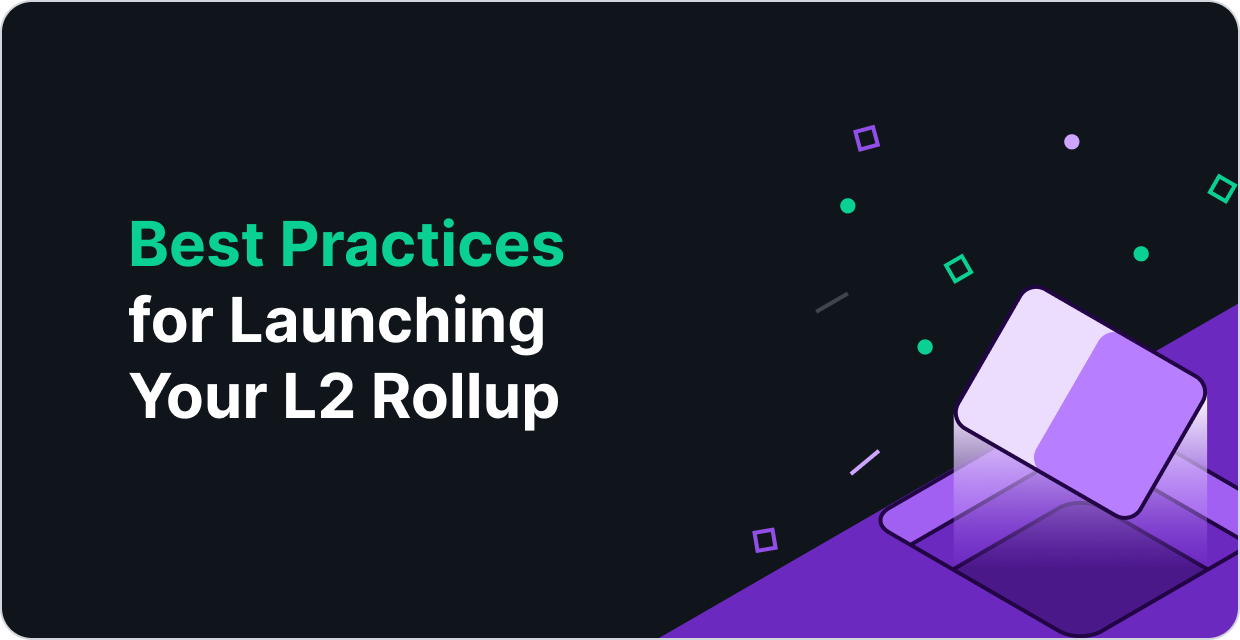Best Practices for Launching Your L2 Rollup
Launching a successful L2 rollup requires careful planning, strategic decision-making, and the right tools. Follow these best practices will help you navigate the challenges and capitalize on the opportunities that rollups present.

Scalability has long been a buzzword among blockchain skeptics. Many solutions aiming to address scalability have often come with significant trade-offs—compromising decentralization, incurring high capital expenditures (CAPEX), or introducing technical complexities beyond the reach of most projects.
Rollups have emerged as the game-changing solution that effectively scales blockchain without sacrificing performance or decentralization.
The ability to customize a rollup is like wielding a superpower, enabling you to build the ideal backend for any decentralized application (dApp) or solution. However, the success of your rollup hinges on more than just deploying the technology; it depends on carefully planning and optimizing every aspect to meet your project's unique needs.
In a previous blog, we covered how to run your own rollup and why you should consider deploying and running your own rollup.
In this guide, we'll walk you through the best practices for launching your Layer 2 (L2) rollup and explore how QuickNode can help simplify the complexities of rollup deployment.
Common Mistakes in Rollup Development
Over the past few years, rollup development and deployment have surged. Despite this, many projects have stumbled upon common pitfalls when developing their rollups.
7 mistakes that can derail your rollup's success:
- Choosing the Wrong Rollup Framework: Selecting an incompatible or unsuitable framework can lead to long-term misalignments such as compatibility issues and scalability concerns. Fixing this mistake often comes at a high cost, including prolonged downtime and loss of users.
- Neglecting Data Management and Availability: Overlooking how your rollup handles data can result in slow performance. Implementing solutions like data compression and integrating external data sources can be technically challenging but are essential for optimal performance.
- Poor State Management Across Nodes: Inefficient state management can cause storage bloat, degrade performance, and hinder scalability. Proper synchronization and pruning are vital.
- Limitations in Configurations: Restrictive settings regarding interoperability or fee management can make your rollup inflexible, limiting adaptability and future-proofing.
- Overlooking Sequencer Decentralization: Failing to decentralize the sequencer can create single points of failure and introduce censorship risks, undermining your rollup's security and integrity.
- Underestimating Infrastructure Costs: Many teams fail to accurately predict ongoing costs such as hosting nodes, API management, data storage, and indexing, leading to budget overruns.
- Lack of Comprehensive Monitoring: Without robust monitoring, security blind spots can go unnoticed, and risk detection is delayed, leaving your rollup vulnerable to attacks or failures.
Avoiding these seven common and potentially fatal mistakes is crucial for the success of your rollup.
Five Best Practices for a Successful Rollup Launch
Based on these common pitfalls, here are five best practices to help you navigate the complexities and successfully launch your L2 rollup:
1. Understand Your Use Case and Needs
The foundation of a successful L2 rollup begins with a deep understanding of your specific use case and project requirements. This involves two parallel approaches:
- Business-Driven Analysis: Assess your target users, expected transaction volumes, and projected growth. Understanding these factors helps align the rollup's capabilities with your business goals.
- Technical Analysis: Examine technical factors such as finality time, proof generation complexity, and the level of ecosystem support required. This aids in selecting a framework that meets your technical needs.
Combining these analyses will guide you in choosing the right rollup framework, data management strategies, and customization options. Frameworks like Optimism's OP Stack, Arbitrum's Orbit Stack, and the ZK Stack are excellent starting points.
2. Build a Robust Node Infrastructure
A reliable and scalable node infrastructure is critical for the smooth operation of your L2 rollup. It ensures performance, reliability, and scalability while providing sovereignty by reducing reliance on external entities.
Options for Building Node Infrastructure:
- Self-Hosted Nodes: Offers ultimate control but comes with significant hardware costs, engineering hours, and requires a dedicated team for maintenance.
- Managed Nodes: Providers like QuickNode handle setup, maintenance, and offer customization at a predictable cost. This frees your team to focus on core development rather than infrastructure management.
Given the advantages, managed nodes are often the better choice for most projects. To maximize their benefits:
- Implement Redundancy and Load Balancing: Ensure high availability and performance, even during peak traffic periods.
- Optimize Geographic Distribution: Deploy nodes in various regions to improve latency and resilience against localized outages.
- Leverage Support and Customization: Utilize the provider's support services and tailor your node infrastructure to your project's specific needs.
QuickNode's Dedicated Clusters offer enterprise-grade node infrastructure with dynamic scaling, global availability, and high redundancy, making it an excellent choice for robust rollup deployment.
3. Think Scalability from the Start
Scalability should be a primary consideration from the very beginning of your rollup's development. Your rollup must handle increased transaction volumes as your project grows and attracts more users.
Key Steps to Ensure Scalability:
- Framework Selection: Choose a rollup framework designed for high throughput and scalability. Frameworks like Optimism's OP Stack or Arbitrum's Orbit Stack are built with these goals in mind and offer modular components that can be adjusted as your needs evolve.
- State and Data Management: Implement efficient state management practices, such as state pruning to remove outdated data. Utilize streamlined data streaming solutions to keep technical debt low and ensure low-latency responsiveness. Apply data compression techniques to reduce on-chain storage.
- Modular Architecture: Design your rollup with a modular architecture to allow for easy upgrades or component swaps. This will future-proof your rollup and provide the flexibility to adapt to new scalability solutions or increased demand without significant rework.
4. Decentralize Sequencing
Decentralizing the sequencer role is crucial for maintaining the security and integrity of your L2 rollup. Sequencers are responsible for ordering transactions and committing them to the rollup, making them a potential single point of failure if not decentralized.
Strategies for Decentralizing Sequencing:
- Rotating Sequencers: Implement a system where the sequencer role rotates among multiple trusted nodes, reducing the risk associated with any single point of control.
- Multi-Sequencer Systems: Employ a setup where several nodes can propose transactions, reaching consensus through majority voting. This enhances decentralization and security.
- Fallback Mechanisms: Establish automatic failover processes to backup sequencers or enable the network to elect a new sequencer in case of failure.
By decentralizing sequencing, you enhance your rollup's resilience, reduce censorship risks, and uphold the decentralized principles of the blockchain ecosystem.
5. Optimize Data Availability
Data availability is a critical component of your rollup's security and efficiency. Ensuring that users can always access the necessary information to reconstruct the rollup's state and verify transactions is paramount.
QuickNode's Streams is a comprehensive data streaming and ETL (Extract, Transform, Load) solution that handles all aspects of blockchain data management.
Benefits of Using QuickNode Streams
- Guaranteed Data Delivery: Provides sequential, continuous blockchain data delivery, eliminating the need for manual querying.
- Data Consistency: Manages varying finality times and potential reorganizations, ensuring consistent and reliable data for your rollup.
- Effortless Integration: Quick setup with just a few clicks across various blockchains, saving development time and resources.
- Historical Data Handling: Easily configure large data batches and specify date ranges for streamlined historical data analysis.
- Cost Optimization: Utilize filters to pay only for the data you need, optimizing costs associated with data availability.
Additionally, Streams offer One-Click Backfills, enabling efficient backfilling of datasets from genesis to the tip of the current block. This ensures your rollup has complete and accurate data to operate optimally.
Set Up Real-Time Monitoring
A comprehensive monitoring and incident response system is essential for maintaining the health and security of your L2 rollup. Proactive monitoring allows you to detect potential issues before they escalate, providing more time to respond and mitigate risks.
Remember, even a single incident causing substantial downtime can prompt users to seek alternative solutions.
Key Components of Effective Monitoring
- Real-Time Monitoring: Implement systems that provide real-time visibility into performance metrics such as transaction throughput, node health, and data availability.
- Automated Alerts: Set up customizable alerts to notify your team of anomalies or performance drops, such as high latency or unusual transaction patterns.
- Predictive Responses: Establish automated actions for common issues, like node restarts or traffic rerouting. QuickNode's Functions can execute serverless operations on blockchain data without infrastructure management.
Capable services like Streams, Functions, RPC, and Alerts can easily be integrated with QuickNode's Rollup-as-a-Service (RaaS) dashboard to visualize metrics and set up notifications, ensuring you're always informed and ready to act.
Maximize Your Rollup's Potential with QuickNode
Launching your own L2 rollup comes with significant challenges—from scalability concerns to managing data availability and ensuring decentralization.
However, by adhering to these five best practices—understanding your use case, building robust infrastructure, decentralizing sequencing, optimizing data availability, and setting up real-time monitoring—you can maximize your rollup's potential and set your project up for success.
QuickNode's Rollup service simplifies the process of building an L2 rollup with its suite of solutions, such as Streams and Functions. By leveraging these tools, you can overcome the complexities of rollup deployment and focus on what matters most: innovating and delivering value to your users.
Get Started Today
Visit the QuickNode Dashboard to deploy your rollup and experience the future of blockchain scalability.
Enhance your existing rollup with Enterprise-Grade Infrastructure
Unlock superior performance, reliability, and cost-efficiency by integrating your existing rollup with QuickNode's industry-leading RPC infrastructure.
Contact us now to learn how to enhance your rollup with unparalleled support and scalability.







